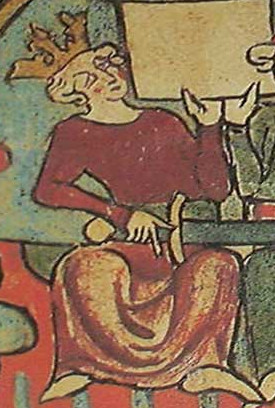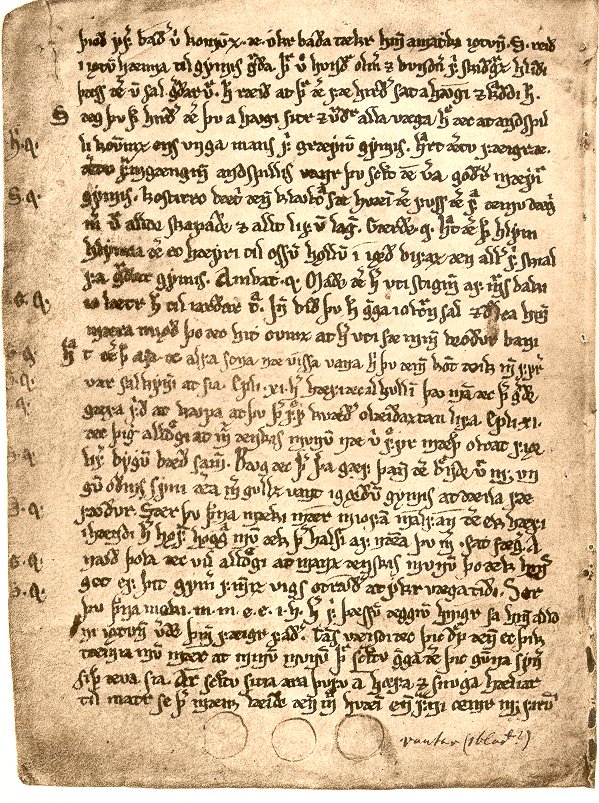|
Drauma-Jóns Saga
''Drauma-Jóns saga'' (the story of Dream-Jón) is one of the medieval Icelandic chivalric sagas, written in Old Norse around the early fourteenth century. It is a comparatively short work compared to others of the genre, and is really more an exemplum than a saga, similar in this respect to the chivalric saga '' Clarus saga'' and the ''ævintýri'' ('exempla') associated with Jón Halldórsson. The work has been attributed to the monk Bergr Sokkason, abbot of Munkaþverá; at any rate it seems characteristic of the work of the North Icelandic Benedictine School The North Icelandic Benedictine School (''Norðlenski Benediktskólinn'') is a fourteenth-century Icelandic literary movement, the lives, activities, and relationships of whose members are attested particularly by ''Laurentius Saga, Laurentius sag .... It was a very popular story, to judge by the number of surviving manuscripts discovered: five on parchment and 45 on paper, with one prominent manuscript being AM 510 4to. ... [...More Info...] [...Related Items...] OR: [Wikipedia] [Google] [Baidu] |
Chivalric Sagas
The ''riddarasögur'' (literally 'sagas of knights', also known in English as 'chivalric sagas', 'romance-sagas', 'knights' sagas', 'sagas of chivalry') are Norse prose sagas of the romance genre. Starting in the thirteenth century with Norse translations of French '' chansons de geste'' and Latin romances and histories, the genre expanded in Iceland to indigenous creations in a similar style. While the ''riddarasögur'' were widely read in Iceland for many centuries they have traditionally been regarded as popular literature inferior in artistic quality to the Icelanders' sagas and other indigenous genres. Receiving little attention from scholars of Old Norse literature, many remain untranslated. The production of chivalric sagas in Scandinavia was focused on Norway in the thirteenth century and then Iceland in the fourteenth. Vernacular Danish and Swedish romances came to prominence rather later and were generally in verse; the most famous of these are the Eufemiavisorna, them ... [...More Info...] [...Related Items...] OR: [Wikipedia] [Google] [Baidu] |
Exemplum
An exemplum (Latin for "example", pl. exempla, ''exempli gratia'' = "for example", abbr.: ''e.g.'') is a moral anecdote, brief or extended, real or fictitious, used to illustrate a point. The word is also used to express an action performed by another and used as an example or model. Exemplary literature This genre sprang from the above, in classical, medieval and Renaissance literature, consisting of lives of famous figures, and using these (by emphasizing good or bad character traits) to make a moral point. Collections of Exempla helped medieval preachers to adorn their sermons, to emphasize moral conclusions or illustrate a point of doctrine. The subject matter could be taken from fables, folktales, legends, real history, or natural history. Jacques de Vitry's book of exempla, c. 1200, Nicholas Bozon's ''Les contes moralisés'' (after 1320), and Odo of Cheriton's ''Parabolae'' (after 1225) were famous medieval collections aimed particularly at preachers. Geoffrey Chaucer's '' ... [...More Info...] [...Related Items...] OR: [Wikipedia] [Google] [Baidu] |
Clarus Saga
Claros (; el, Κλάρος, ''Klaros''; la, Clarus) was an ancient Greek sanctuary on the coast of Ionia. It contained a temple and oracle of Apollo, honored here as Apollo Clarius. It was located in the territory of Colophon, which lay twelve kilometers to the north, one of the twelve cities of the Ionian League. The coastal city Notion lay two kilometers to the south. The ruins of the sanctuary are now found north of the modern town Ahmetbeyli in the Menderes district of Izmir Province, Turkey. The Temple of Apollo at Claros was a very important center of prophecy, as in Delphi and Didyma. The oldest literary information about this sacred site goes back to the sixth and seventh centuries BC, through the Homeric Hymns, though Proto-Geometric pottery at the site betokens 9th century occupation. A sacred cave near the Temple of Apollo, which was an important place both in the Hellenistic and Roman eras, points to the existence of a Cybele cult in early periods here. Games c ... [...More Info...] [...Related Items...] OR: [Wikipedia] [Google] [Baidu] |
Jón Halldórsson
Jón Halldórsson (c. 1275 – 2 February 1339, or Candlemas; Modern Icelandic: ) was a Roman Catholic clergyman, who became the bishop of Iceland (1322–1339). He served in the diocese of Skálholt. He grew up in Norway as a friar of the Dominican order and has been assumed to have been of Norwegian birth, though since his mother's name, Freygerðr, is unknown outside Iceland, he may in fact have been (half) Icelandic. He studied both theology in Paris and canon law in Bologna, and his learning is seen as remarkable in contemporary Icelandic sources; '' Laurentius saga'' has him as one of Iceland's two best Latinists at his time, as fluent in Latin as in his mother-tongue. He was elected bishop following Grímr Skútuson and consecrated on 1 August 1322 but did not arrive in Iceland until the following year. He was noted for bringing the Icelandic Church more closely into line with canon law and for his skill as a preacher and storyteller; the introduction to ''Klári saga'' c ... [...More Info...] [...Related Items...] OR: [Wikipedia] [Google] [Baidu] |
Bergr Sokkason
Bergr Sokkason was an Icelandic monk, abbot and scholar, who flourished in the earlier fourteenth century. In 1316 he became a monk of the monastery of Þingeyri before moving to the monastery of Munkaþverá, where he became prior in 1322 and abbot from 1325–34 and again from 1345, apparently to 1350. It is not known when Bergr died: the last known mention of him is in 1345. Bergr was a close friend of Lárentíus Kálfsson and Einarr Hafliðason and seems to have been one of the most prolific identifiable authors of medieval Iceland, making him a central figure in the North Icelandic Benedictine School of saga-writing: he wrote '' Nikulás saga erkibiskups'' and '' Mikaels saga höfuðengils''; possibly '' Guðmundar saga C'', the L-version of '' Jóns saga helga'', and '' Jóns þáttr Halldórssonar''; and maybe even a number of romances: '' Kirjalax saga'', '' Rémundar saga keisarasonar'', and ''Dínus saga drambláta''. It has recently been argued that he also composed th ... [...More Info...] [...Related Items...] OR: [Wikipedia] [Google] [Baidu] |
North Icelandic Benedictine School
The North Icelandic Benedictine School (''Norðlenski Benediktskólinn'') is a fourteenth-century Icelandic literary movement, the lives, activities, and relationships of whose members are attested particularly by ''Laurentius Saga, Laurentius saga biskups''. This movement is characterised by an elaborate (or 'florid') rhetorical style new to Icelandic saga-writing at the time (known in English as the 'florid style', Scandinavian as the ''florissante stil'', and Icelandic as the ''skrúðstíll''), with Latinate grammar, Latin and Low German loan-words; and, unusually for Icelandic sagas, which are usually anonymous, a close-knit network of identifiable authors (sometimes self-identified, sometimes named by others). The school is associated particularly with the Northern Icelandic Benedictine monasteries of Þingeyri and Munkaþverá in the diocese of Hólar, and with the students of Jón Halldórsson and Lárentíus Kálfsson. The principal authors and works associated with this l ... [...More Info...] [...Related Items...] OR: [Wikipedia] [Google] [Baidu] |
Tómasarbók
Tómasarbók (Reykjavík, Stofnun Árna Magnússonar, AM 510 4to) is a mid-sixteenth-century Icelandic manuscript. It was written between 1540 and 1560 by Ari Jónsson and his sons Jón and Tómas Arason. It contains eight sagas, including one of the two main sources of ''Finnboga saga ramma'' and the youngest version of ''Jómsvíkinga saga'', which may contain interpolations from an older, independent version of this saga. Eight of the eleven remaining stanzas of Tindr Hallkelsson's '' Hákonardrápa'' are preserved in this version of ''Jómsvíkinga saga''. Contents As catalogued at Handrit.is, the manuscript contains the following texts: * ''Víglundar saga'' (1r-8r) * '' Bósa saga'' (8v-21r) * '' Jarlmanns saga og Hermanns'' (21r-32v) * '' Þorsteins þáttur bæjarmagns'' (32v-38v) * ''Jómsvíkinga saga'' (38v-67r) * ''Finnboga saga ramma Finnboga saga ramma () (The Saga of Finnbogi the Strong) is an Icelandic saga that recounts the life of Finnbogi rammi. The story ... [...More Info...] [...Related Items...] OR: [Wikipedia] [Google] [Baidu] |
Chivalric Sagas
The ''riddarasögur'' (literally 'sagas of knights', also known in English as 'chivalric sagas', 'romance-sagas', 'knights' sagas', 'sagas of chivalry') are Norse prose sagas of the romance genre. Starting in the thirteenth century with Norse translations of French '' chansons de geste'' and Latin romances and histories, the genre expanded in Iceland to indigenous creations in a similar style. While the ''riddarasögur'' were widely read in Iceland for many centuries they have traditionally been regarded as popular literature inferior in artistic quality to the Icelanders' sagas and other indigenous genres. Receiving little attention from scholars of Old Norse literature, many remain untranslated. The production of chivalric sagas in Scandinavia was focused on Norway in the thirteenth century and then Iceland in the fourteenth. Vernacular Danish and Swedish romances came to prominence rather later and were generally in verse; the most famous of these are the Eufemiavisorna, them ... [...More Info...] [...Related Items...] OR: [Wikipedia] [Google] [Baidu] |
Icelandic Literature
Icelandic literature refers to literature written in Iceland or by Icelandic people. It is best known for the sagas written in medieval times, starting in the 13th century. As Icelandic and Old Norse are almost the same, and because Icelandic works constitute most of Old Norse literature, Old Norse literature is often wrongly considered a subset of Icelandic literature. However, works by Norwegians are present in the standard reader ''Sýnisbók íslenzkra bókmennta til miðrar átjándu aldar'', compiled by Sigurður Nordal on the grounds that the language was the same. Early Icelandic literature The medieval Icelandic literature is usually divided into three parts: *Eddic poetry *Sagas *Skaldic poetry The ''Eddas'' There has been some discussion on the probable etymology of the term "Edda". Most say it stems from the Old Norse term ''edda'', which means great-grandmother, but some see a reference to Oddi, a place where Snorri Sturluson Snorri Sturluson ( ; ; 1179 – 22 S ... [...More Info...] [...Related Items...] OR: [Wikipedia] [Google] [Baidu] |


